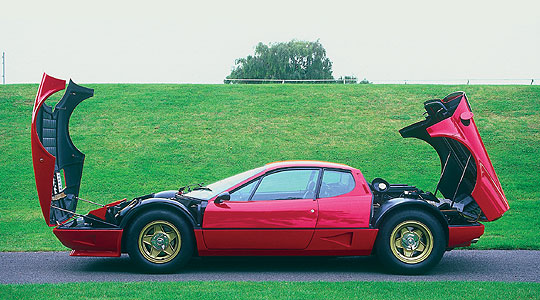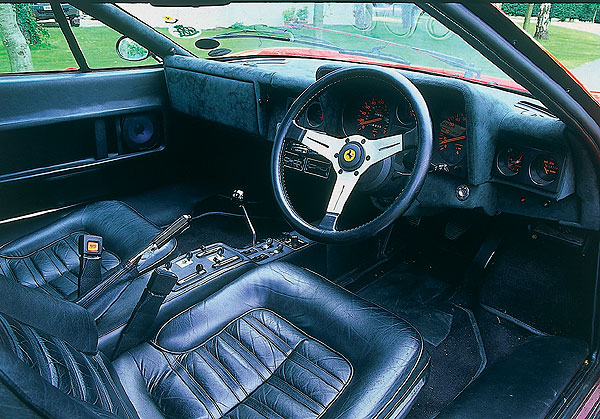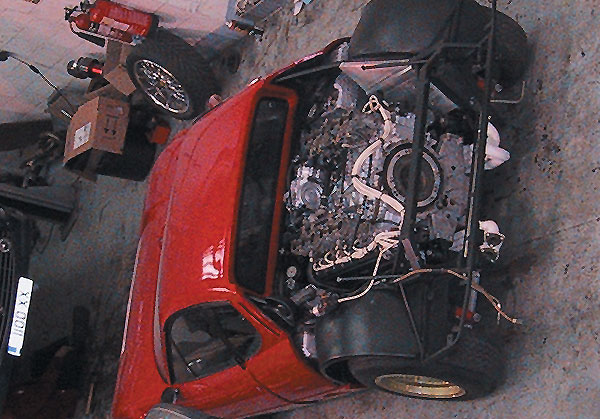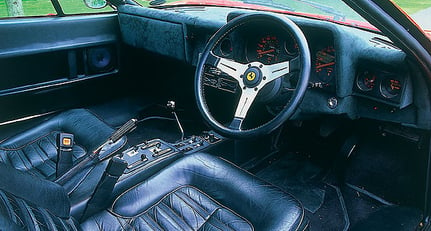The following is an extract from Simon Park's feature in Auto Italia magazine, Issue 114 2005. For access to the full feature, plus articles on the Alfa Romeo 8C2600, the Siata 1300TS, a Supercar Triple Test, the Vernasca Silver Flag Hillclimb 2006, and much more, see www.auto-italia.co.uk

It was that tractor bloke with the bull-fetish and an axe to grind who started it all. The mid-engined Lamborghini Miura wowed the world in 1966. But Enzo Ferrari was not a man to cower before such an upstart and his answer, when it came two years later, was the resolutely old-school, front-engined 365 GTB/4. But, successful though the Daytona was, it was clear that, sooner or later, Maranello would have to play Sant’Agata at its own game. When finally it took to the field, at the Turin Show of 1971, it found that the goalposts had been moved, and its prize stallion now faced an altogether wilder breed of bull in the mad, bad Countach.
But, with the 365BB, Pininfarina’s Leonardo Fioravanti had surpassed himself and his perfectly proportioned, classically elegant design – devoid of any Lambo-esque flamboyance – was an instant hit. Having thus titillated and tantalised both the press and prospective customers, Ferrari could afford to take his time, and production didn’t start until late 1973.
Underneath the all-steel (with aluminium ‘openings’) bodywork was a square-section tubular steel central monocoque, behind which was cradled the new 4390cc flat-12, with a claimed 360bhp at its disposal. With two pistons sharing one crankpin this wasn’t really a proper ‘boxer’ engine, just a 180º ‘V’12. Its longitudinal mounting ensured lower cabin noise levels and better accessibility than the Miura’s transverse layout (Lamborghini came to the same conclusion with the Countach) but necessitated the gearbox sitting underneath it, alongside the sump. This, together with the various ancilliaries on top of the engine, negated much of a horizontally-opposed cylinder configuration’s inherent advantages in terms of vertical weight-distribution.
The aim of the 512, introduced at the 1976 Paris Salon, was greater driveability. Increases to both bore and stroke brought capacity up to 4943cc, which logically made the new car a ‘412BB’. Quite why Ferrari reverted to its traditional racing nomenclature (512 indicating five litres and 12 pots) is one of those curious Italian conundrums to which there is either no answer, or half a dozen. Maximum power either went down, or they stopped telling fibs, since it was now quoted at just 340bhp. It arrived nearly 1000rpm earlier, though, and torque was up by 10%. Dry sump lubrication was the only other major mechanical change while externally, 512 distinguishing features include a full-width chin spoiler, four rather than six exhaust tail-pipes and rear light units, NACA ducts in the rear sills to assist brake-cooling and one inch-wider rear wheels (you noticed, huh?).

In 1981 the ageing pugilist grew softer still when it became the last production Ferrari to dump its vociferous Webers in favour of Bosch K-Jetronic injection – truly the end of an era. Gone was the primal roar, to be replaced by nice, touchy-feely ‘driveability’. Think Frank Bruno playing Buttons.
But here we have the full-fat, high-cholesterol, real thing – warbling Webers and all. The last time we were at Goodwood, the race-prepared Maserati I was supposed to track-test fell foul of the noise police. This time it was a road-going Ferrari and… guess what. It was the sonorous Tubi exhaust system that did it but no matter; have car, will drive. Despite being less than four feet tall, the Boxer is easy to board, and getting comfortable is easier still. The seat is cosier than it looks and everything falls beautifully to both hand and foot. But Ferrari interiors have come on a bit these last 30-odd years. The orange-on-black instruments, and the switches and sliders with their trademark flat Bakelite ‘paddle’ knobs, all work well, but the less said about some of the trim and panel fit the better.
Yet when you get going such trivia pale into insignificance. Any Ferrari is a unique aural and sensual experience but few, if any, supercars (that I’ve driven, at least) make you feel at home so quickly. This came as quite a surprise – suddenly, the big, beefy Boxer felt smaller, friendlier, and far more focused than I’d imagined it would be. The heavy clutch I did expect, but the open-gated gearchange is a delight – far nicer than that of the mid-’90s 456GT I drove recently. The brakes need a good shove but are otherwise viceless, and toe-heeling’s a doddle. Big fun, too – the sound of that flat-12 ‘blipping’ on the approach to one West Sussex roundabout after another is unforgettable.


The unassisted steering starts light, around the straight-ahead position, but loads up big time as you reach the extremities of lock. Feedback is excellent, however. Initially there’s some understeer, as you’d expect – at lower speeds in particular – but a message from your right foot to the engine soon sorts that out. It’s always behind you, figuratively as well as literally, that flat-12. Power delivery is seamless and linear, with no obvious ‘jump’ point. There’s some momentary low-speed fluffiness (typically, out of those roundabouts) if you try to pile on too much too soon, but once the Webers have cleared their throats it’s fun-time – goodbye tailgating Audi, hello horizon. Even by today’s standards, this is a seriously quick car.
The suspension manages to offer both a flat, roll-free stance and a very acceptable ride – helped by the tall, period-profiled Michelins whose grip is impressive. It was a salutary reminder of the price we pay for the dubious advantages of today’s rubber-band tyres. For all its apparent agility and user-friendliness, however, you’re always aware that this is a full-size mid-engined supercar with 60% of its 1580kg biased to the rear, and a centre of gravity higher than you might think. Un-sticking the rear end of such devices is something best left for the track (a wide one, at that) and there was certainly no way I was going looking for its limits on what were fairly busy public roads.
And anyway, such antics are not what the BB is about. Though Pozzi, Chinetti and others succeeded in making a worthwhile racer of it, the Boxer is, first and foremost, a high-speed grand routier par excellence. Bendy back-doubles would soon tax your stamina but stick to the wide, open sweepers and you’ll have more fun than you know what to do with.
|
Words by Simon Park and pictures courtesy of Phil Ward.
See www.auto-italia.co.uk or call +44(0)1858 438817 for back issues and subscriptions. |
ClassicInside - The Classic Driver Newsletter
Free Subscription!





